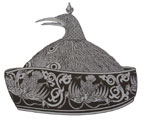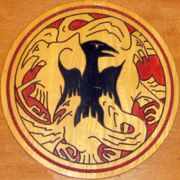A Goddess of natural cycle. With the natural cycles of the land so threatened and damaged the battle aspect cannot be ignored.

‘All that is perverse and horrible among the supernatural powers’, A Goddess of battles who appears in the form of a scavenging scald-crow or a ragged winged raven, glorying in death and battle’.
This is the commonly held image of the Morrigan in folklore and story telling and in this form she plays a significant part in both the mythological story cycle, and the Heroic cycle.
Before the Battle of Magh Tuireadh, she promises Lugh that she will pursue any who seek to flee from battle. She draws ‘the blood of his heart’ from the Formoire leader Innneach stealing his power, and offers two handfuls of this blood to his foes at the Ford of Destruction.
She also prophecies the Tain and seems to be there at significant points, disturbing and troubling its unfolding. In her first meeting with Cuchulain she is revengeful when her advances are rebuffed and she is there at his death.
She is, indeed, portrayed as wild and war loving. One late text describes her as “shrieking triumphantly over fighting soldiers….a lean hag, speedily leaping over the points of their weapons and shields.” So she comes down into our time as a figure presiding over death and destruction or dwindled into dark and fearful figure, leading spirits out of the Otherworld cave entrance of Cruachain at Samhain and the dark enemy of children’s stories.
But it is not just as a wild haired grey and nimble hag, pouring curses, hailstones and fiery showers on the assembled enemies of her people that she enters into the old stories. She may equally appear as a strong and beautiful woman as when she meets and mates with the Dagda before the battle against the Formoire.
A crimson robed, flame-headed warrior , she appears coming out of the Sid of Cruachain bringing a red eared white heifer to the brown Bull of Cuailnge.
“…..a chariot harnessed with a chestnut horse. The horse had but one leg and the pole of its chariot passed through its body,…..Within the chariot was a woman, her eyebrows red and a crimson mantle round her. Her mantle fell behind her between the wheels of the chariot so that it swept along the ground……..”
She appears to Cuchulain in similar form calling herself the King of Buan’s daughter and offering him her treasure and herself . She is also a powerful shape-shifter appearing as a white heifer, an eel, a wolf, an otter as well as the more usual crow, black bird or raven.
It is generally accepted that Morrigan (Mor Rioghan, Morrigu) has the meaning of Great Queen or possibly Phantom, i.e. Otherworld Queen. It is certainly a title rather than a name. In the glossary to the Battle of Magh Tureadh her names are given as Danu and Ana, (Anu). Now Ana is one of the oldest names of the Great Mother Goddess and in that or similar forms the name appears in mythologies from all over the world. She was Anna-Nin, Lady of Heaven in Sumeria, Anat in Canaan, Anatha in Syria, Nanna in the Norse lands, Hannah, Di-ana, Inanna, Anna Perena, Grandmother time; the list is endless. She is the Great-mother, the Grand-mother and it is hardly surprising that She is remembered in Christian mythology as the Grandmother of Christ.
In Celtic mythology she is remembered as Anu, Danu, Mother of Her people, the Tuatha De Danaan. Her name is commemorated in the landscape, as in the Paps of Anu in Killarney, and elsewhere. (There are small hills known as “The Paps of the Morrigan” in Co. Meat). Anu, Danu, is the giver of Gifts, of inspiration of brightness. but she is also the bring of sleep and darkness. Danu’s children revered the night and gave darkness precedence over day. And in folklore she becomes both the bright fairy woman, Erin and the black ‘witch’ Anis . As Great-Mother she encompasses both light and dark, both giving and receiving back.
If She is the ‘Great Queen’ of Ireland then the stories will show evidence of her sovereignty. There are many stories of a prospective king who is met and tested by a woman who changes from old to young, from hideous to beautiful These encounters often take place near water so that it is not unexpected to find that the Dagda mates with the Morrigan as she stand bathing with one foot on each bank of the river.
It is interesting that when she offers herself to Cuchulain he refuses her ‘queenship’. Is the story seeing Cuchulain as a “solar hero”, a patriarchal warrior type who no longer seeks the mating with the Goddess of the land? Perhaps, although other aspects of his myth do not wholly bear this out. Even so the Cuchulain story belongs to the ‘heroic’ rather than the ‘mythological’ cycle.
These great Goddesses are always triple and the Morrigan is no exception. She is usually viewed as one of a triad of sisters, including Badhbh, and Macha.
Macha is also a Goddess of the Land. Besides the well known story of her race with the king’s horses and her birthing curse on the warriors of Ulster there is also the story of how she laid out the boundaries of Emain Macha with her broach pin. She is the horse Goddess and protector of her people.
Nemain is another known war Goddess as is Fea. At the battle of Magh Tuireadh they are all mentioned as wives of Nuada so perhaps they are all aspects of the Goddess of the land evoked for protection.
And why have they remained, remembered only as Goddesses of war and battle? The Goddesses of the Sacred Land, and all land is sacred, are givers of prosperity and fertility. Their chosen ones were pledged to uphold and cherish the gifts of the Goddess.
Maybe there are clues in the stories. Macha’s secrets are raped and her gifts abused through pride and jealousy. When she is forced to race against her own natural cycles and to give birth before her time her blessing becomes a curse. When Cuchulain refuses the Morrigan’s gifts he begins a cycle of competition rather than co-operation. Is it any wonder that she is perceived as angry? He wounds her in her shape shifted forms and is only healed when he consents to drink from the teats of her cow and offers a blessing. He accepts her nourishment and healing takes place.
It is clear that in the stories, conquest of the land becomes paramount. and therefore conquest of the Goddess by whatever name she is known. How can it be otherwise when She is the land. Where we seek to abuse, there we also fear. She has become the recipient of our fearful projections and so becomes fearful herself.
So why Morrigan healing? If we regard her as dark and fearful then we will treat the Sacred land in the same way. If we see her as guide and protectress then she will grant us the clear vision of her ravens. Her healing will be cleansing, not easy maybe, because as the earth rots away and transforms all that is dead, or as fire consumes and transmutes static energies, or as the scavengers pick clean, so her cleansing is to the bone. Not easy, but what she transforms is cleansed to health.
Remember that after the Tain, the cattle raid, it is she who tells the trees and the rivers the outcome. It is she, who after the battle of Magh Tuireadh, sings the song of blessing and regeneration.
Peace up to the skies;The skies down to the earth;The earth under the skies;Strength to everyone.
A Goddess of natural cycle then, And with the natural cycles of the land so threatened and damaged the battle aspect cannot be ignored. But if we are cooperating with her and not in competition then any conflict will become part of the healing process, not an end in itself.
The Morrigan; Goddess of no pain, no gain.
Reprinted From Sheela-Na-Gig Magazine

















